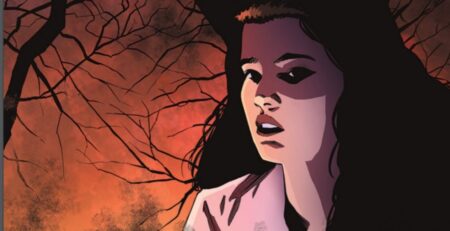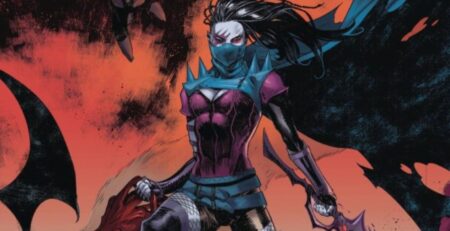
The Crossroads at Midnight is published by Iron Circus Comics. It is written and drawn by Abby Howard. This graphic novel contains a collection of five short horror stories. Each story focuses on a different place and characters, as well as a different genre of horror.
In “The Girl in the Fields,” the story begins with a girl named Frankie talking to someone on the other side of a fence. The other person’s name is revealed to be Clara as the two discuss their lives. Frankie is having difficulties at home after her extremely religious parents learned she was a lesbian. Clara sympathizes, and the two begin to form a friendship. But as tensions rise at home, Frankie decides to get out, only to find that sometimes running away can cause new, terrible problems.
This serves as a strong opening and thesis to the entire anthology of horror. Howard crafts a believable portrait of the rejection of modernity that happens too often in the midwest and bible belt. Frankie is a normal teen who throws herself into danger because of her parents’ ignorance and intolerance. Too often, these situations are done in a classist or elitist way, but this story feels organic. When the horror finally hits, it comes in a surprising and effective way. It also has one of the most brutal deaths I have ever seen in a comic, which helps bring everything together.
In “Mattress, Used,” Christina, a college student, has just found a new mattress for her room on the curb. Her schoolwork keeps her too busy for a job, and as a result, she has been without a bed all semester. She brings it home and shows it to her roommate Alexis who is immediately distrustful. That night Christina goes to bed and dreams a horrific creature with puckered skin is in her bed. It tells her it wants her skin and licks her hand, which causes her to wake up screaming. She shrugs it off as sleep paralysis and goes about her day. But as Christina’s health begins to fail, it becomes clear that it may not have just been a dream.
This is a brilliant story about the poverty that students are often forced into, mixed with millennial/gen-z fears of doctor visits. Christina makes a questionable decision, not because something is wrong with her, but because she can’t afford to make a better one. This spirals into her avoiding serious medical care until it’s too late. Horror is best when it’s timely and mirrors reality, and this story exhibits that wonderfully. When you mix in the grotesque body horror and bleak ending, its effectiveness soars.
In “The Boy from the Sea,” Nia is a young girl forced to play by herself after her sister, Ayanna, ditches her for new friends. This changes when a mysterious boy named Gregory meets Nia on the beach and asks her to play games with him. She tells him about playing pretend and her love of scary and weird things. He responds by showing her that he has the power to control water. That night Nia returns to play with him, but Ayanna catches her and tells her that she doesn’t trust the boy. But Ayanna’s words of caution are ignored, and soon, Nia finds herself in grave danger.
This story really hit me hard. I’m the oldest of three siblings, and I’ve been the one who abandoned them to spend time with my friends and do what I wanted to. While I didn’t have mysterious water boys harassing them, I did miss time that I could have spent bonding. This story does a phenomenal job as an analogy of how the bonds we form or break when we’re young can be hard to strengthen later in life. It wasn’t as scary as some of the others, but the ending was chilling and heartbreaking.
In “Our Lake Monster,” Mary-Anne and her family live in a house next to a lake. That lake also happens to be the home of a sea-monster. While Mary-Anne watches it swim at night, her brother Joshua asks about it, and the two talk about how their father used to give tours of it until it killed someone. Now, the family struggles to make ends meet, and the adults have to work until late at night at the mill to put food on the table. But monsters aren’t always friendly, and sometimes it’s better to leave well enough alone.
An excellent cryptid horror story also serves as a look into how our social institutions can be responsible for our harm and struggles. The dangerous jobs that people do can be banned or shuttered with no social safety net. This results in poverty and struggles for people who once relied on them to make a living. Then, with no path forward provided for them, those people look to the harmful past. Combine this with an effective monster that is never fully revealed, and you end up with some strong social commentary.
In “Kindred Spirits,” an old woman named Norah lives by herself in the woods near a bog. One night she sees a pair of eyes looking at her through the darkness. She leaves some food outside against her better judgment and goes inside. She is surprised to hear a knock at the door and even more surprised to see the visitor is a walking corpse. Grabbing her gun, she returns to find that the corpse has a gift for her, a locket. She invites the corpse inside, and she talks while it listens. At dawn, the corpse leaves, and Norah finds herself with more questions than answers. But when she searches for the truth, she may not be ready for what she finds.
The fifth and final story in this anthology is chilling, somber, and beautiful. Society can be extremely calloused toward our elderly. A story about a woman talking to a ghost may seem outlandish at first. But Norah lives alone and is largely forgotten by the world. Her attempts at outreach to others are rebuffed, and she’s forced into solitude with her failing body. The parallels between a forgotten ghost and an abandoned older woman are striking. Soon, even the horrific rictus stricken face of the ghost seems almost warm.
With the individual recaps done, I’d like to talk about the outstanding artwork. The entirety of The Crossroads at Midnight is done in black and white. Normally a lack of color can feel drab, but Howard’s work proves to be the exception. The gruesome body horror and horrific violence seem all the more graphic because your imagination has to fill in the rest. The hideous puckered man in Christina’s bed can be any color, and that’s terrifying. When compounded with the strong art that is reminiscent of Edward Gorey, it feels exceedingly macabre. There were a few panels where I was distracted by people’s mouths as just hollow and black. But that’s the biggest gripe I have about this book.
Overall, I’m in love with The Crossroads at Midnight. I regularly sing the praises of anthology horror, and this graphic novel exemplifies the strength of the genre. The stories are chilling and varied, the art is strong and evocative, and the social commentary is on point. Despite being over 300 pages long, the book absolutely flies by and will leave you wanting more. Fans of horror, this one is a must buy.
The Crossroads at Midnight will be available on February 23rd.
The Crossroads at Midnight
TL;DR
I’m in love with The Crossroads at Midnight. I regularly sing the praises of anthology horror, and this graphic novel exemplifies the strength of the genre. The stories are chilling and varied, the art is strong and evocative, and the social commentary is on point.







